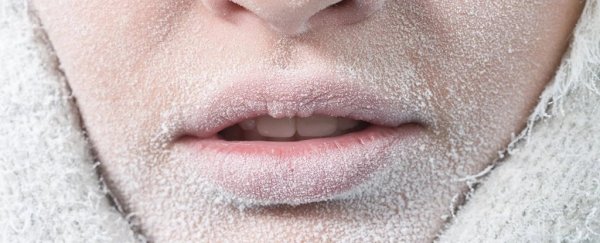
Decades Ago, A Woman Survived Being 'Frozen Solid'. Here's The Science
MIKE MCRAE 2 AUGUST 2022Early one New Year's Eve morning in Minnesota, back in 1980, a man named Wally Nelson stumbled across the body of his friend, lying in the snow just a few meters from his door.
Nineteen-year-old Jean Hilliard's car had stalled while returning to her parents' house after a night out. Dressed in little more than a winter coat, mittens, and cowboy boots, she set out into the minus 30 Celsius (minus 22 Fahrenheit) night air to seek her friend's assistance.
At some point, she tripped and lost consciousness. For six hours, Hilliard's body lay in the cold, warmth draining away to leave her – by several accounts – "frozen solid".
"I grabbed her by the collar and skidded her into the porch," Nelson would report years later in a Minnesota Public Radio interview.
"I thought she was dead. Froze stiffer than a board, but I saw a few bubbles coming out of her nose."
If not for Nelson's prompt response, Hilliard might have just become one of the thousands of deaths chalked up to hypothermia each year. Instead, her tale has become a part of medical lore and a scientific curiosity.
How could a body survive being frozen solid?
Stories of people surviving freezing temperatures are unusual enough to be newsworthy but aren't exactly rare either. In fact, medical specialists in cold climates have a saying: "Nobody is dead until warm and dead."
The realization that extreme hypothermia isn't necessarily the end of a life has become the basis of therapy in itself. Under controlled conditions, lowering body temperature can cool down the metabolism and reduce the body's insatiable hunger for oxygen.
In medical settings, or on rare occasions elsewhere, a chilled body can put the brakes on the whole dying process long enough to deal with a low pulse, at least for a while.
Where Hilliard's account stands out is the extreme nature of her state of hypothermia.
Forget the fact her body temperature was barely 27 degrees Celsius, a full 10 degrees below that of a healthy human. She was – apparently – frozen. Her face was ashen, eyes solid, and her skin reportedly too hard to be punctured by a hypodermic needle.
In the words of George Sather, the physician who treated her, "The body was cold, completely solid, just like a piece of meat out of a deep freeze."
Yet within just a few hours, warmed by heating pads, Hilliard's body returned to a state of health. She was talking by noon, and with little more than some numb, blistered toes, was soon discharged to live an unremarkable life unaffected by her night as a human popsicle.
To friends and family in her community, it was all thanks to the power of prayer. But where does biology stand on the matter?
Unlike many materials, water takes up a greater volume as a solid than it does as a liquid. This expansion is bad news for body tissues caught in the cold, as their liquid contents risk swelling to the point of rupturing their containers.
Even a few stray ice crystals blooming in the wrong place can pierce cell membranes with their needle-like shards, reducing extremities to blackened patches of dead skin and muscle, or what we commonly know as frostbite.
Various animals have evolved some nifty adaptations to deal with the dangers of sharp, expanding ice crystals in sub-freezing conditions. Deep-sea fish known as Antarctic blackfin icefish produce glycoproteins as a kind of natural antifreeze, for instance.
The wood frog turns the contents of its cells into a syrup by flooding its body with glucose, thus resisting freezing and dehydration. Outside of their cells, water is free to turn into a solid, encasing tissues in ice and making them look, for all purposes, as solid as frog-shaped ice cubes.
Without anything more to go on than external observations, it's hard to say for sure how Hilliard's body withstood being frozen. Was there something unique about her body chemistry? Or even the make-up of her tissues?
Maybe. A far more important question is what exactly 'frozen' means in this case. Although low, Hilliard's core body temperature was reportedly still far above freezing. There's a world of difference between a metaphorical 'chilled to the bone' and literal solidified water in the veins.
The fact Hilliard's body felt solid is a common sign of severe hypothermia, as muscle rigidity increases to such an extent, it can even resemble rigor mortis, the stiffening that happens to a dead body.
That the surface of her body was cold and white, and even her eyes appeared glassy and 'solid', might also be less than surprising. The body will close off channels to blood vessels under the skin to keep organs functioning, to the point a body will look ashen and remain remarkably cold to the touch.
For medical staff persistent enough to try their luck using a smaller gauged hypodermic on heavily constricted veins, especially if they're covered by thin layers of dehydrated skin pressed tight against rigid muscles, we might even imagine a bent needle or two could result.
With little to go on other than a few surprised accounts, we can only speculate whether Hilliard's 'frozen' body was typical, if shocking, or indeed strangely unique in its ability to withstand such an extreme change of state. There can be no doubt, however, that she was fortunate.
The more we learn about the amazing things the human body can achieve, the less we might rely on good fortune to save lives like hers in the future and more on advances in medicine and rapid responses.


comment 0 Comments
more_vert